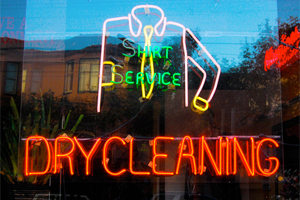
“Tis the season…” with looking at holiday parties and getting dressed in our finest clothes, often clothes that can’t or shouldn’t be just tossed in the washer and dryer. Is traditional dry cleaning safe? I don’t think so. Heard of PERC? Read on….
What is PERC?
It’s an acronym for tetrachloroethylene, also known as perchloroethylene. (If you can pronounce these you’re a rock star!) PERC is the primary solvent used in 85 percent of the approximately 35,000 dry cleaners in the U.S. (Green American)
According to the Environmental Protection Agency (EPA.gov) and the World Health Organization, PERC:
- Is a “likely human carcinogen.”
- Tends to linger in dry-cleaned clothing, slowly outgassing into your car, home and closet.
- Causes an increased cancer risk, as high as 140 to 190 in 1,000,000 with dry cleaners located in residential areas exposing neighboring businesses and residents.
- Can enter the body through inhalation, skin contact and by drinking contaminated water.
- Has been linked to developmental, respiratory and other health problems, including: nerve and brain damage, dizziness, fatigue, headaches, unconsciousness, liver and kidney damage, bladder and esophageal cancer with long -term inhalation.
- Has also been linked to reduced fertility.
- Can show up in the milk of nursing mothers, also placing infants at risk.
- Is used in paint strippers, spot removers and other solvent- based household products.
Are there Healthy Alternatives to Traditional Dry Cleaning? Yes there are!
When I absolutely MUST take a favorite piece of clothing that can’t be laundered at home, I take it for “wet cleaning.” Several years ago I found a progressive cleaner here in Denver (Green Care Cleaners) and could not be happier. My clothes come back clean, soft and I know that toxic chemicals are not coming into our home. This process also presents a reduced health hazard to its employees and is better for the environment. While green cleaning is somewhat more expensive, to me it’s worth it for the health and environmental benefits.
What is Wet Cleaning?
Wet cleaning is an EPA approved alternative to traditional dry cleaning that involves laundering garments with environmentally safe detergents in a computer controlled washer and dryer. I also appreciate that wet cleaning is free of VOCs (Volatile Organic Compounds-toxic!)(Green American)
To read more about wet cleaning click here.
Another green garment cleaning method uses Liquid Carbon Dioxide (CO2) in place of PERC along with other non-toxic-cleaning agents. Consumer Reports found that liquid CO2 performed even better than PERC. To read more about it, click here.
Where do I find professional wet cleaners in my area?
Other Green Alternatives to Solvent-based Dry Cleaning:

In addition to using dangerous chemicals, Dry Cleaning adds significantly to unnecessary plastic and other waste for packaging garments for delivery.
Let’s face it… suits, beaded garments, delicate lace, winter coats really DO need professional cleaning.Over the years, I’ve learned that even though a particular garment may be labeled “Dry Clean Only,” gentle hand washing or lightly steaming, can be a more than adequate substitute. With steaming, I just place the article in my dryer with a damp colorfast towel and run a normal cycle. Voila!
Also, I recently read about “The Clothing Cocktail,” and I will definitely have to give it a try! One sprays inexpensive vodka (not rubbing alcohol) on clothing, especially where perspiration has collected. The alcohol from the vodka kills bacteria that causes odor, then dries quickly. Cool! (Mother Earth Living)
Here’s a great article on other non-toxic–cleaning alternatives you can use at home! http://www.rodalenews.com/dry-cleaning-alternatives
I’m always trying to reduce the number of garments I am forced to take in for professional cleaning. I’m working to re-evaluate my wardrobe to include more low-maintenance garments with environmentally friendly fibers such as bamboo, organic cotton, silk and wool. I’m also trying to wear my clothes longer, recycling what doesn’t fit or is too expensive to maintain. This is so much healthier, saves me money in the long run and leaves a gentler environmental footprint.
The Nature Conservancy notes the following environmental impacts on clothing production: Energy, Water, Land and other natural resources and dyes and bleaches, even for fibers like bamboo and rayon. I had no idea about the chemicals used in some of the natural fibers.
Somewhere along the line I hope that all cleaners can find a way to replace the plastic bags that are used to cover clothing. They are not environmentally friendly and out-gas their own chemicals. That’s why I always air out my clothing for a good 24-hours, after I pick them up, but before they go back into my closet.
To be totally candid, when I learned about the toxicity of PERC in dry cleaning it scared the $#%^ out of me. In my previous life as a professional I had been dropping my favorite blouses, trousers and jackets off at a PERC dry cleaners and bringing them home for years. Not healthy for my children or for me.
PERC is another toxic chemical that I had no idea was so harmful, or so pervasively used. I hope to continue working towards more savvy, greener shopping and “home cleaning” of more of the clothing I own. For me, the bigger picture involves not only health for me but for the global community! I invite you to join me!
Say no to PERC!
Clean green and be healthy!
DEC

